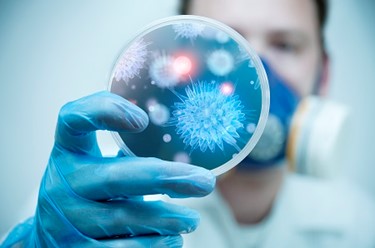Immediate Benefits Of Real-Time Microbial Monitoring
By Troy Tillman, Business Manager, TSI Inc.

Companies producing medicines and biotech products are concerned with airborne microbial contamination. They need to ensure that products and people are kept safe. The traditional, accepted method to test for microorganisms at critical locations in a process is the use of Active Air Samplers or Settling Plates. Typically, 1-meter-cubed samples are taken onto agar plates and sent to a lab for culturing. The Colony Forming Units (CFUs) results come back from the lab after 4-10 days. Only after this waiting period will end users know whether the manufacturing environment was in control. Recently, the commercialization of a technology based on Laser Induced Fluorescence (LIF) has made it possible to look at airborne viable microbial counts in real time. The potential to instantly respond to an airborne microbiological event when it happens is exciting – and beneficial.
Root Cause Analysis
Results from Active Air Samplers are important – they can inform us that there has been a problem, possibly an excursion of some kind, and also enable identification of the microorganism to support a root cause investigation. However, they do not tell us when the contamination happened, or the source of the contamination. New LIF-based bio-detection products can provide better insight into these unknowns by measuring airborne viable particle counts and displaying this data in real-time. The data can be viewed via a local display or integrated directly into a Facility Monitoring System (FMS).
An example is contamination that comes from workers, particularly when they start a shift in a cleanroom. By having data to support the impact of gowning practices on cleanliness, companies can provide enhanced training programs. Once root causes are identified, actions can be taken to rectify the issue, be it training, ventilation, filtration, machine maintenance, or facility adjustments.
Process improvement
One challenge in critical ISO 5 or Grade A pharmaceutical processing environments is that they are very clean. Much cleaner than when the cleanliness limits detailed in the cGMP Aseptic Processing guidance was conceived. Today, Grade A Isolators are continuously monitored for airborne contamination using active air samplers, settle plates, and traditional optical particle counting technology. When correctly designed, these environments easily meet and exceed the airborne cleanliness requirements as defined in the GMPs. In some cases, many weeks, months, and even years will pass without any airborne microbial contamination being detected using current methods. Similarly, low numbers are seen in surrounding Grade B environments.
It is surprising, then, that these very clean critical processes have to be interrupted, growth media introduced or manipulated, in order to meet the regulatory requirement for AAS environmental monitoring. The good news is these potentially hazardous and disruptive process steps are unnecessary with real-time airborne viable particle counting technology. Real-time viable particle counters not only offer the potential to monitor these very clean and well controlled environments, but can also provide continuous data when integrated into an FMS System.
Summary
Do regulators embrace new technology and information? The resounding answer appears to be yes. Regulatory bodies certainly want to ensure that medicines and biotech products are safe for consumers. To that end, they want to be sure that root causes are identified, with corrective and preventative actions put in place. And they want process improvements to provide an even higher level of safety in the future. Vendors of real-time viable particle counters have submitted a Type V Drug Master File (DMF) with the US FDA. This provides the FDA and customers with a file that demonstrates the science behind the technology, as well as the test results to support the measurements.
Troy Tillman is a Business Manager at TSI Inc. He has spent over 20 years defining and developing products for markets such as pharmaceutical cleanrooms, laboratories, hospitals, and vivariums. He has held various product management, marketing, and business development positions at TSI. He has been an active member in IEST, ASHRAE, and CETA, speaking at numerous conferences. He holds a Bachelors of Mechanical Engineering and an MBA from the University of Minnesota.
